DI Optical USA EG1 Red Dot Sight
Most shooters in the U.S. are not familiar with the DI Optical EG1 red dot sight. I must admit, I was not familiar with it either before my introduction. When people think of rifle optics, they typically go to mass market US manufacturers that have been around for a while….because anything else is an outlier not worthy to be placed amongst the Alphas.
Most often, that has also been my impression. In all fairness though, every manufacturer deserves their fair shake: People will talk, tests will be conducted, and opinions will be formed. The following will be my opinion which is based on my direct experience with the DI Optical USA EG1 red dot sight.
The EG1 is certainly unique in the market. In fact, while I certainly cannot say that I have seen every optic out there, I can definitely say that I have not seen one quite like this. It seems to be a mix between a red dot optic and laser based Eotech. To be clear, the EG1 is fully LED based, so in that sense, it is absolutely NOT like an Eotech. However, it has some similar features that remind me of the “feel” of an Eotech. I’ll start off with some high-level details:
– It has a very large field of view
– The LED fires from the bottom of the sight
– The LED is reflected off of a mirror on the roof of the sight
– It’s a very short sight
– Battery life is a little better than the Eotech
– It has very little parallax
– It has Night Vision modes
I’ll go into these in more detail below. But I think by the end of this review you will see that with this sight, DI Optical USA has offered a unique product that many would appreciate.
Weight and Dimensions:
The weight of the EG1 red dot sight is not something to brush aside: To be clear, this sight is built like a tank for its’ size, coming in at 11.66 oz. There is some serious heft in the construction of the body; it’s got a very thick base and thick walls. It is to be assumed that if you are going for a lightweight build, this sight will not likely be what you’re looking for.
As for the dimensions, it’s relatively compact: From the rail, it sits at about 2 3/8″ high off of the rail, is about 1 1/2″ at the top and 1 11/16″ at the zero adjustments (the brightness dial adds an additional 7/16″), and the body is 2 1/2″ long (3 13/16″ if measuring from hood to hood). At the end of the day, without the hoods, you can say it’s 2.5″ x 1.5″ x 2.5″ (LWH).
FOV and Image Quality:
In my opinion, the strongest selling point of this red dot sight is the Field of View and glass quality. Other than the Eotech or the new Vortex Laser based AMG UH-1, you will be hard pressed to find a red dot optic that has a larger field of view. Unlike the laser based variants, which are rectangular, the EG1 has a hexagon shaped window to look through. But just like the laser based variants, the glass is 100% clear with ZERO tint! Most red dots have a bluish shade to the glass when looking through them: This is to create an additional level of contrast for the red dot that is superimposed against the target so that it stands out better. Not having the tint is a good (and bad) thing: On one hand, the bluish tint adds distortion to the natural color of the target image and reduces the light coming through the optic. However, not having the tint requires using more battery to get the same perceived reticle brightness, so battery life may suffer a little more.
Another HUGE selling point for me was that as you move the optic around, there is ZERO image shift or distortion exhibited on the EG1 red dot glass. Some red dot sights, such as the Trijicon MRO, have a very slight magnification to them to refine or enhance the definition/resolution of the sight picture. Unfortunately the little added definition it may give comes at the trade-off in the form of a skewed/distorted sight image. People’s reaction to this distortion vary greatly….from “I don’t even notice it” to “Completely unacceptable, I can’t get rid of this thing fast enough!”. It gives some people headaches and can contribute to eye strain. For me, it’s is only an annoyance.
Parallax:
The EG1 is advertised as “Parallax Free”, as most red dot sights are. But the truth is, NO sights or scopes are truly parallax free. Even the highest end Alpha scopes costing multiple thousands of dollars exhibit a parallax correction adjustment. Red dots are no exception, and neither is the EG1. However, optics do differ in the amount of parallax exhibited. For those who do not know what parallax is, it is the basically the amount of shift in reticle position in relation to the target while moving the eye’s position through the optic’s view. For instance, if you place the optic on a table and move your eye around through the optics’ view (without moving the optic) and notice the reticle moving off of its’ “zero”, the amount of shift away from the zero is the measurement of parallax. All sights exhibit parallax especially at close ranges, but most will claim “Parallax Free” beyond a certain distance…usually 25+ yards. In my experience, the best I have seen is parallax free from about 15-20 feet.
In regards to the EG1, the parallax is not noticeable unless really close to your target. And in practice, one would be hard pressed to find that it affects the point of impact at all. Given what red dot optics are primarily used for (fast, heads up target acquisition), you will never notice the parallax when running and gunning. I would argue that even while benching your rifle, you wont notice any position shift.
Technology and Brightness:
The DI Optical USA EG1 red dot sight utilizes “Current Dimming” technology for the LED. This is typically the standard that I have seen in optics, which is likely due to Current Dimming being a more efficient use of power than Pulse Width Modulation dimming. If you are not familiar with either of these, you might not even care. However, I am extremely sensitive to PWM LED’s. I first noticed them on car tail lights when driving and scanning the road. I found that certain newer LED tail light based cars had a sort of flicker to the lights when I moved my eyes around and could never figure out why this happened. Well, if you’ve never noticed this, count your blessings: You are not susceptible to it. I however, am very sensitive to it. PWM basically turns the LED on and off very quickly for different lengths of time to decrease LED brightness. Current Dimming, on the other hand, decrease or increases the current to the LED to control brightness. Therefore it is “constantly on”, just with less or more current. This technology will not exhibit any flickering.
As for the brightness of the reticle in the EG1, it is not quite up to the level of typically recognized Alpha products such as the Trijicon MRO or Aimpoint variants. I’ve seen Aimpoints get very bright, but since I do not have one I cannot assess the differences side by side. However, I do have the MRO and cranked both the MRO and EG1 up to their max potential. The MRO was a measure brighter, but only by one notch. So the EG1’s brightest setting matched the MRO’s second brightest setting. I think this may only come into play in the brightest of environments, such as a sandy desert at noon. Not that you wouldn’t be able to see it, but that it’s not going to overpower everything in the sight picture by a wide margin. I have found Eotech’s reticle to be the brightest that I’ve experienced so far, having aimed one very close to the sun on a lightly hazy day (white and bright conditions) and still being able to see the reticle. Under normal conditions, the highest settings of the Eotech literally hurt my eyes.
Finally, I’ll speak on the internal arrangement of the EG1. Differing from any other red dot sight I’ve ever seen, the EG1 fires its LED from the bottom, hitting a roof mirror and then bounced back onto an angled internal prism, which is then reflected back to your eye.

The only downside to this that the LED can be seen from the front hitting the angled internal prism. The dot is so small from the front that I really can’t see any practical detriment to this, but some might see this as a draw back to being “visible” from an enemy position. Not having ever been in a battle environment, I cannot speak to the reality of how concerning this might be. However, the brightness is not like seeing a flashlight towards your enemy: I have a hard time seeing the dot from the front at its brightest settings across the room in a dimly lit environment. When your engagements are a healthy measure of distance greater than a family room, I just don’t see this being a problem. And furthermore, you won’t have it turned all the way up in dimly lit environments, rendering it invisible. It is because of this upward firing LED format that I believe DI Optical USA was able to reduce the parallax error that is more commonly seen in reflexive/side led-firing red dots.
Controls:
The EG1 Red Dot Sight controls are very straightforward: A large dial on the left side controls the on/brightness level, and two small dials on the right side adjust the zero position. The brightness dial is probably just too stiff. It’s more a preference thing, but I would like to see it be just a tad bit easier to turn. At the end of the day though, I would rather it settle for having a stiffer dial than a loose dial that could get bumped. There are definite “click-into-positions” but they are not audible. There are a total of 16 settings: 0 = off, 1 – 4 are Night Vision modes, and 5 – 15 daytime use modes. Depending on brightness, I would say outside modes will float between 10 and 15, while inside/night time use will probably be between 5 and 9. My only complaint on the brightness adjustment is that there are not off positions in-between brightness levels.
Zeroing requires use of a small coin or flat head screw driver; they are not finger-adjustable. The zero dials are flush with the body and really cannot be knocked out of adjustment, so that is a plus. The dials have very positive clicks and are not mushy at all….definitely one of the better feeling dials, in my opinion. One of the odd things to me is that DI Optical USA chose to have 1 MOA movement per click, not the standard 0.5 MOA per click. This means a harder time fine tuning your zero if you need to go in-between clicks. To me, this is a red dot sight: Fine tuning is not required….just a nice option to have. I can make due with 1″ clicks. 1/2″ would have been preferred, but oh well.
Battery Life:
The battery life on the EG1 is listed in the manual to be 9073 hours @ level 6. That’s about 378 days, or let’s call it 1 year. Not bad. However, level 6 is all but useless for outside/daytime shooting, so I am left wondering….what is the battery life at the higher levels? Their website says “5000 hours at mid brightness”, where “mid” can mean 7 or 8. I found someone else online say that setting 13 gives about 2000 hours. The manufacturer informed me that at the highest level, a new battery will last about 1680 hours, or 70 days straight. Eotech battery life on the highest setting is around 750-800 hours, so basically double the time. Even still, I would not consider the EG1 Red Dot Sight to be an efficiency powerhouse….it’s about par for the course and usable daylight modes are rated in hours/days, not years. In a nutshell, battery life, while not bad, is not the innovative part of this red dot sight.
Price and Warranty:
The current going market price for the EG1 is around $425. While the EG1 is certainly unique and has benefits over the plethora of other options out there, I feel it is going to be difficult to gain mass market adoption while selling at this price. At least in the beginning. The problem is not what you are getting for the price, but rather DI Optical coming into a crowded market at an Alpha level price. If I know the shooting community, and I think I do, most shooters looking in this price range would rather opt for a brand that they know has stood the test of time in the U.S. market and has the backing of the shooting community and military. Even if it has a long reputation in South Korea, DI Optical is relatively new in the U.S. market, and will be viewed as such. It is my opinion that in order to gain marketplace adoption in the U.S., the price is going to have to decrease: It takes a long time to establish oneself as worthy to compete with Alpha brands amongst shooters in the U.S. We’re a picky bunch, and “fanboyism” runs wild in our community. Basically, either the price has to entice people to take a chance on a new product (enough to overrule the lure of more expensive Alphas), or the product better be something that is so radically different that people are willing to part with their money to be early adopters. I think the EG1 is somewhere in the middle. Maybe I am wrong, I don’t know. Time will tell. I don’t know if dropping the price is a realistic thing to do for DI Optical, as I have no clue what the costs involved are to manufacture the EG1. It’s certainly made with high quality components, so I can’t imagine it’s cheap to make.
As for the warranty, I happened to able to test out DI Optical USA’s warranty service, which actually excited me (being a product reviewer). The first unit I tested exhibited noticeable parallax at all distances, so something was internally askew. So I contacted DI Optical and submitted for a return and was given a label to return the broken unit. They confirmed that the sight exhibited a very abnormal amount of parallax, and I received a new unit a week later. So I can attest that their warranty service works. All DI Optical USA red dot sight products come with a 3 year warranty for manufacturer’s defect, provided that 1) It was purchased from an authorized reseller, 2) The product was used under normal conditions, and 3) The unit has been modified by anyone other than DI Optical USA. This means that if you drop your red dot sight and it stops working correctly and clearly shows user-caused damage, that won’t be considered a manufacturer defect: You must buy a new sight or cover cost of repairs. It also does not cover batteries. But if within 3 years, you happen to find your sight not working correctly and was not cause by owner abuse, then you can submit for warranty work. Sure it’s no Vortex warranty, but honestly, how many companies can afford to do that?
Conclusion on DI Optical EG1 Red Dot Sight:
The DI Optical USA EG1 Red Dot sight is definitely unique. It kicks the idea that a red dot has to be a long tube with a tiny field of view and blue tinted glass. While a bit large of a footprint, that enables the large field of view that no other red dot offers. It also feels indestructible with it’s solid body block of aluminum.
In a nutshell, the main benefits are: Field of View, ruggedness, and glass clarity. Couple that with very little parallax, ZERO image distortion and no noticeable reticle blooming, and you have one heck of a red dot package. Target acquisition is extremely quick and the large field of view makes the rest of the body disappear from your peripheral vision.
The downfalls of the EG1 are: Short battery life in relation to other products, weight (for a lightweight rifle) and if you care, a front-visible dot. It’s not really fair to single this out on the EG1 though because all reflexive/prism based red dot optics will have visible LED’s through the front lens. The EG1 just happens to have the dot in the middle instead of on the side. Only true holographic sights are not visible front the front.
One quick note: This sight is meant for rifles like the AR-15, where the stock is basically at the same height as the rail. If you have a rifle like the CZ Scorpion EVO, HK G36, AK-47/74, etc, the rail sits a bit too high in relation to where your cheek rests on the stock, and will require more of a “chin-weld” cheek position. I personally don’t like having to raise my head off of the stock to get a proper sight picture, so because of this, I cannot recommend this sight for these types of rifles…..at least without getting a stock cheek riser.
All in all, I am very impressed with the performance of the DI Optical EG1 red dot sight. I love the field of view and the crystal clear, non-skewed image you get. When people see it, they go, “Wow, what is that? Can I see through it?”. Because it bucks the traditional red dot form factor, it draws attention. If you value these attributes in a red dot optic, you should seriously consider this sight as your primary weapon optic.
For more manufacturer information, please go to: DI Optical USA – EG1 Red Dot Sight
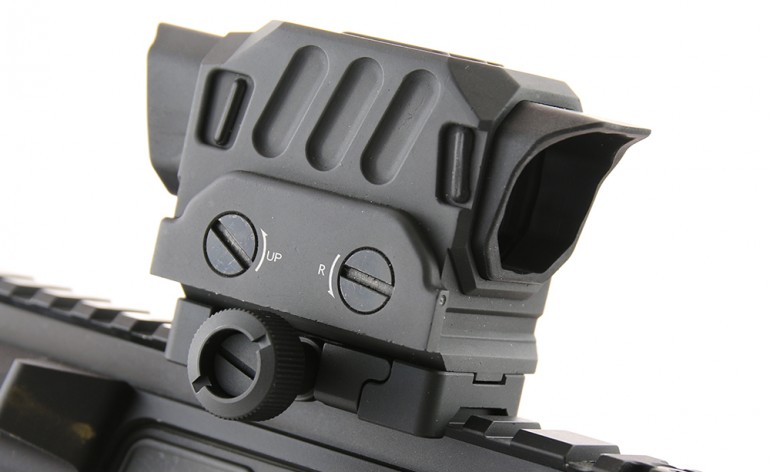
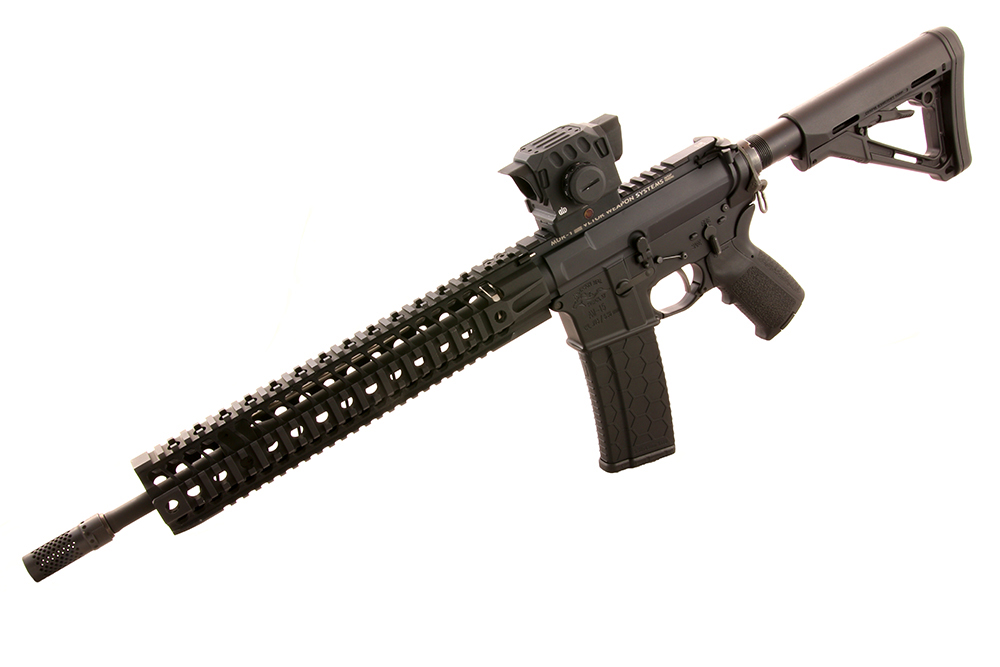
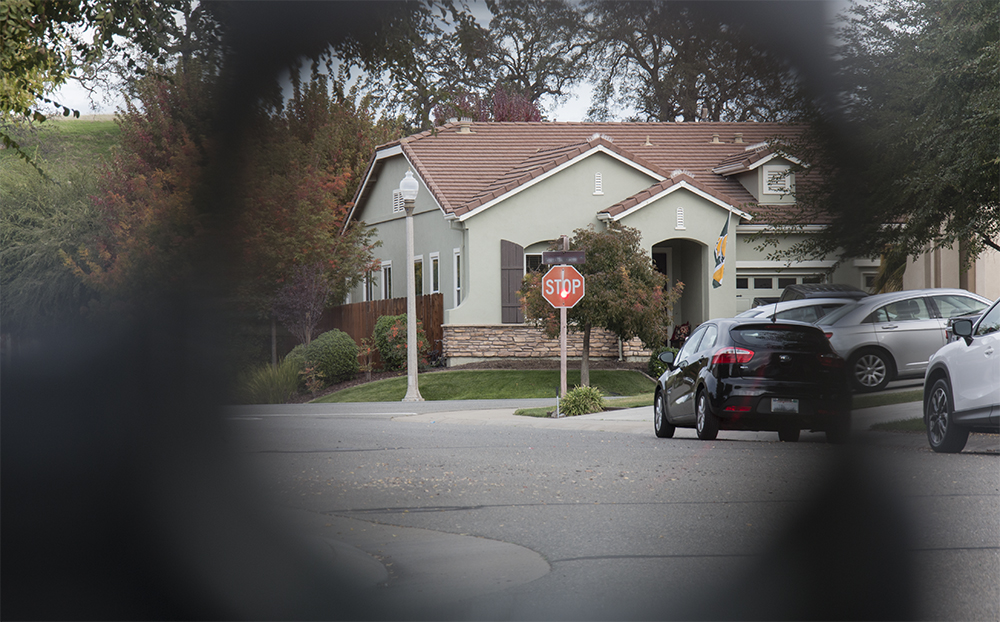
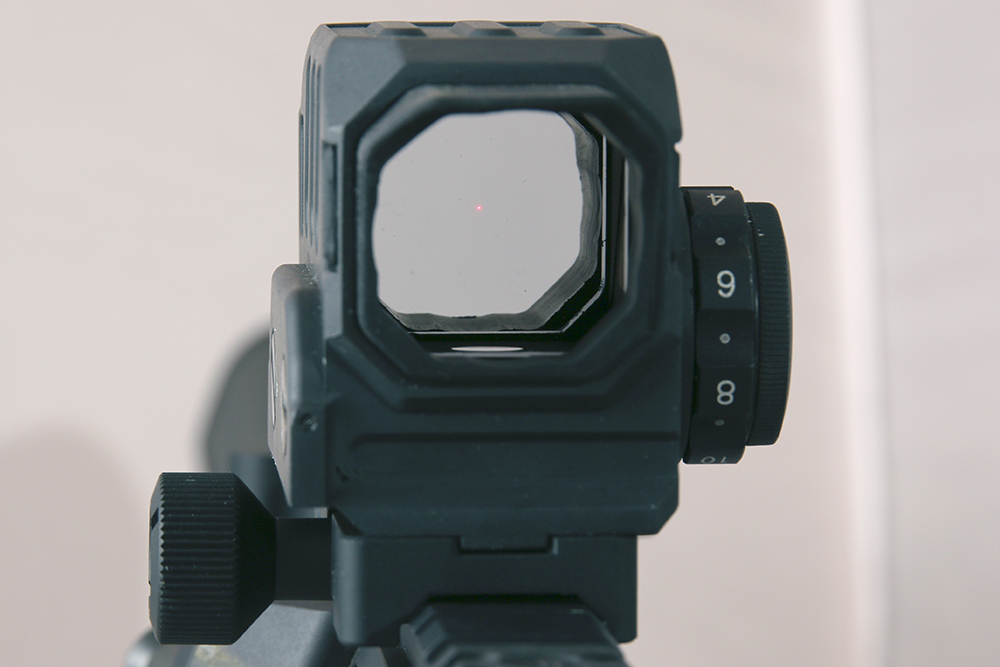
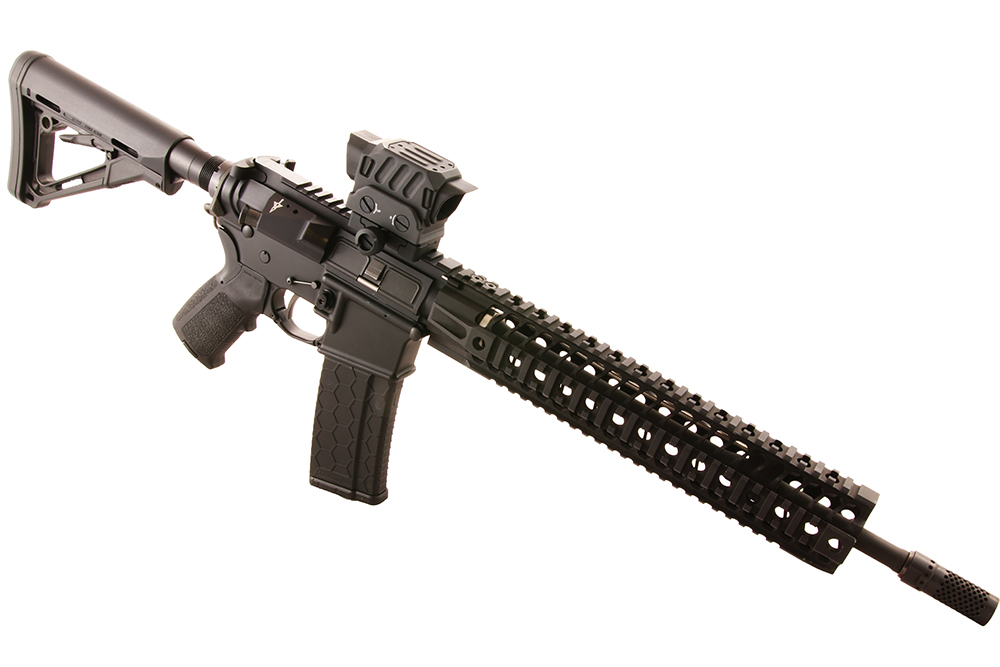
Pingback: DI Optical RV2 Red Dot Sight - Firearm Reviews
Excellent review! I’m currently in the market for a sight for a Steyr AUG. This sight’s military equivalent (DCL30) has been on my short list. I’m debating though between the DCL30/EG1, and the EXPS2.0, MRO and UH-1. They each seem to have their plusses and minuses. Any thoughts as to which of those mentioned would be your go-to sight for a patrol rifle/defensive rifle? Battery life is NOT a top deciding factor.